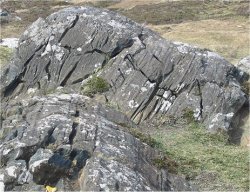
March Editorial
Rocks that absorb CO2

March Editorial
Rocks that absorb CO2
|
|
In today's environmentally-challenged conditions, global warming is on almost everyone's mind. Whether or not you agree with scientific predictions of global warming and the harm caused by high levels of CO2 in the atmosphere, there can be no doubt that reducing CO2 emissions will not do any harm and may do a great deal of good. Of course, trees and other plants absorb CO2 and recycle it as oxygen. But they cannot absorb the CO2 as fast as humans are pumping it out. So the challenge is on to find alternative methods of removing CO2 from the atmosphere. One idea which has been proposed and already implemented is pumping liquid CO2 underground (see our earlier editorial). While much better than nothing, this approach has many drawbacks, including too few suitable underground stores and the danger of CO2 leaking back out again. So scientists have been looking for a new approach. Researchers from Columbia University's Earth Institute have just proposed a novel method which involves utramafic rocks. Ultramafic rocks are igneous and meta-igneous rocks which are characterised by a low silica content (less than 45%). These rocks are rich in magnesium and iron and are dark in colour. A typical ultramafic rock is peridotite , pyroxenite or dunite. Ultramafic rocks are a major component of the Earth's mantle, and some ultramafics are released into the Earth's crust when continental plates collide with oceanic plates. Ultramafic rocks were also exposed to the surface during the highly volcanic period of the Archaean eon (about 2.5 billion years ago). What makes ultramafic rocks special is that when they are exposed to carbon dioxide, they react with it to form common limestone and chalk. This process is known in geology as mineralization. The scientists from the Columbia University's Earth Institute, in collaboration with the U.S Geological Survey, have been mapping surface ultramafic rocks in the United States. They have located large clusters of these rocks along the east and west coasts. Large utramafic strips have been also found near major cities including New York, Baltimore and San Francisco. Sam Krevor, who is a leading participant of this study, estimates that the United States’ ultramafic rocks may be sufficient to stash more than 500 years of CO2 production by the United States. Large areas of ultramafic rocks have also been found in Australia and Euroasia. The major drawback to natural mineral carbonation is its slow pace: normally, it takes thousands of years for rocks to react with sizable quantities of CO2. But the authors of the study have an answer to this. The process can be accellerated by dissolving the CO2 in water and directly injecting it into the rocks. The heat generated by the process can be reused to pump even more CO2 into the rocks. Although the present study concentrated on ultramafic rocks, other rocks such as volcanic basalts can also absorb carbon dioxide. Which means that the Earth will not run out of CO2 absorbing rocks in the near future. If you are a sceptic of global warming and the urgency of extracting CO2 from air, there is one more twist to this story. As we all know, asbestos is ahighly carcinogenic material and even when shut down, old asbestos mines are still a risk to the nearby population. But the mineralization process make the crushed rocks left lying around these old mines harmless. However, the idea of accellerated CO2 absorbtion is still in the early stages, and only time will show how effective the mineralization process may be in making our planet safer. Adapted from materials provided by The Earth Institute at Columbia University. |
| _______________________________ | ||||
| Home | | | Shopping | | | Database |
© Biscuit Software 2004-2015
All rights reserved